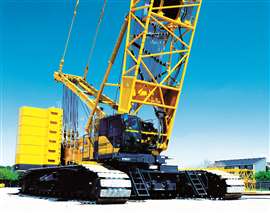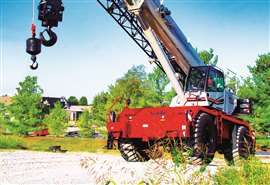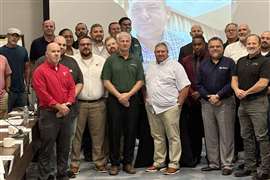Read this article in French German Italian Portuguese Spanish
What are the biggest issues in equipment financing?
03 June 2024
When speaking with customers, dealers and manufacturers, the most common question we hear is “What are you seeing out there?” This is more prominent now than ever before since we have inflation, volatile interest rates and are in an election year.
 Buyers should look at the payment, not only the rate. If the payment fits their budget and the new acquisition will allow their business to grow, it may be a deal worth doing. PHOTO: Kobelco Cranes
Buyers should look at the payment, not only the rate. If the payment fits their budget and the new acquisition will allow their business to grow, it may be a deal worth doing. PHOTO: Kobelco Cranes
So, what are we seeing and how is it affecting heavy equipment financing? In the current environment, business continues to be steady and customers are cautiously optimistic. There is still a limited supply chain, which is making it difficult for people to find both new equipment and quality used equipment. However, they do have jobs for these cranes. Workforce shortages and inflation are also causing some hesitation. Banking regulations, such as Basel III and fraud prevention are causing a tighter credit market. Therefore, closing transactions takes longer. Lastly, current interest rates are definitely giving customers some heartburn when purchasing.
When discussing “cautiously optimistic,” let’s put it in perspective. According to the Association of General Contractors of America (AGC) DataDigest, (5.10.2024), “Construction was listed first among 14 sectors (out of 18), paying higher prices and was among sectors reporting growth (12 sectors), and an increase in business activity (13 sectors).” In this same report, construction was one of the five sectors that were also reporting slower supplier deliveries. As noted, the jobs are there, which is giving customers, manufacturers and dealers optimism, but it is harder, more expensive and it takes longer to get projects done.
Regarding equipment, customers are still buying as they need equipment to service their jobs, but the limited supply chain has made it difficult to find equipment. Dealers and manufacturers still seem to be a year or more out on new orders for some models. For used equipment, it is difficult to find quality equipment. Some dealers are not taking used equipment in on trade as they do not want to tie up their inventory lines or make a number of repairs needed to make a unit saleable. As a result, we are seeing a large number of private party and/or user-to-user transactions. There are lenders, including Harry Fry & Associates and our lending partners, that will do these types of transactions, but there are a vast number of lenders that will not. In addition, private party transactions require much more due diligence as well as resources, and as a result, may take longer to close.
Increased banking regulations are causing a tightening in the current credit environment. Are lenders still approving and funding deals? Yes, but it’s taking longer. The largest issues facing banking and lending right now is Basel III and fraud prevention. Basel III is an internationally agreed upon set of measures developed by the Basel Committee on Banking Supervision as a response to the banking crisis in 2007-2008. Essentially, banks need to maintain a higher capital reserve as a precaution for financial distress, which means higher deposit accounts.
As a result, if banks do not increase their deposits, they will be offering a lower number of loans to borrowers. The implementation date for these reforms was January 1, 2023. Banks that offer commercial lending are being much more cautious and particular regarding who they lend to. It is why they are asking more questions, and want to see additional information when reviewing a credit package. This can also affect down-payment/Loan to Value (LTV) requirements as they may be higher in order to reduce loan amounts on their books.
 Increased banking regulations are causing a tightening in the current credit environment. Photo: Link-Belt
Increased banking regulations are causing a tightening in the current credit environment. Photo: Link-Belt
Preventing fraud
Fraud prevention continues to be a major issue in banking and lending that is affecting the finance process. Fraud is increasing exponentially both in business and our everyday lives and is ever changing. When approving and closing transactions, lenders are going through multiple layers of due diligence. They are digging deeper into a customer’s credit, business and personal profile. For vendors, their background is being reviewed as well. How long has the vendor been in business? Do they have a “storefront” and/or physical location? What is their web presence? Do they have the equipment they are selling in their possession? These are just a few examples, but all things that add time to closing transactions.
Despite issues facing lenders, financing is still available. However, customers need to be prepared to provide more information than they normally have in the past, and also, know that both the approval and closing process can take longer than they are accustomed to. Even if your company is a long-established company with good credit history, you may need to be prepared for additional questions and/or information to be provided.
Lastly, interest rates remain a concern. It is the most widely asked/commented topic we hear about from borrowers today. Prime rate is currently 8.5 percent, more than double from its most recent low of 3.25 percent in March 2020. We have to remember that Covid was having an enormous impact on the US economy at that time – businesses were struggling to keep their employees working and projects were postponed or cancelled. Reducing the interest rate helped entice companies to purchase equipment and borrow.
During the Covid pandemic, many were able to stockpile cash and had some pent-up demand to purchase. With the limited supply chain issues and increased demand for products on a worldwide basis, prices began to rise at a very fast pace. To calm the pace of rising prices, the Federal Reserve raised interest rates 11 times from March 2022 to July 2023. Since then, rates have remained fairly steady.
Although the interest rates are the highest they have been in a decade, companies are asking themselves if it makes sense to borrow and add equipment to their fleet.
■ Does it make sense to lose out on jobs because you don’t have the equipment and possibly stagnate the business?
■ Does it make sense to rent equipment from a competitor to service the work and possibly lose a customer to the competitor?
■ Does it make sense to buy now and grow your business?
I think one of the largest misconceptions about interest rates is that a 1 or 2 percent decrease in an interest rate is going to make a significant impact on the payment. As an example, a 7.5 percent interest rate for 60 months on $100,000 yields a payment of $2,003 per month. With a 9.5 percent interest rate, it yields a payment of $2,100 per month, a $97 per month increase. Even with the same parameters on $1,000,000, the payment difference is not that significant, on a monthly basis. At 7.5 percent, the payment is $20,037 per month, and at 9.5 percent is $21,000 per month, a $963 per month difference. We do understand that the increased interest cost adds up over time. However, in current times, buyers should look at the payment, not only the rate. If the payment fits their budget and the new acquisition will allow their business to grow, it may be a deal worth doing.
Despite rates being higher, a limited supply chain, and financing taking a bit longer, there is still business to be had. Companies still have projects and need equipment to complete those projects. Banks are still lending. Is it a different business environment? Absolutely. We just need to approach it with an open mind and a bit of patience.

THE AUTHOR
Tonya DiGregorio, CLFP, vice president of Harry Fry & Associates, has been in the crane and financing industry since 2004. With a degree in economics from Stonehill College, she is a past chairman the SCR&A Allied Industries Group and holds the designation of Certified Leasing and Finance Professional. She previously worked at State Street Bank as a portfolio administrator in the mutual funds and private equity division.
STAY CONNECTED


Receive the information you need when you need it through our world-leading magazines, newsletters and daily briefings.
CONNECT WITH THE TEAM












